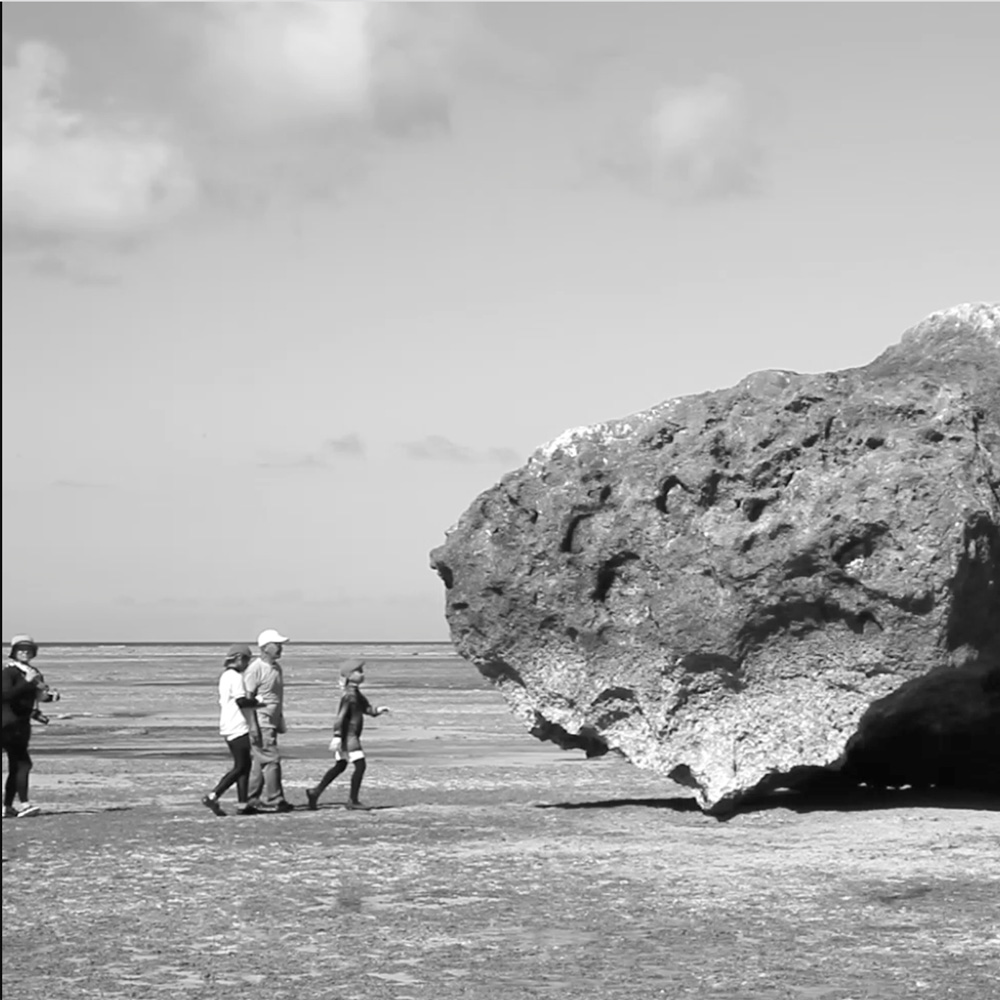土方浦歌
下道基行は、すでにそこにありながら私たちに見えていない「かたち」を見せてくれる。日本国内に残された砲台や戦闘機の格納庫などを訪ねた《戦争のかたち》(2001-2005年)では、それらが農家の倉庫として利用されていたり、別の用途を持って風景の中に埋もれていたりするのをみつけ、記録し伝えた。《Re-Fortプロジェクト》(2004年-)では、そうした戦争の遺構で缶蹴りや打ち上げ花火を行なうなど、機能を失った建物に別の機能を与えることで、過去と現在をつなぎ、共有されていない記憶と残されたかたちとを結びつけた。私たちが普段の生活の中で認識の外に置き、見ようとしていないことに対して、それが風景の中に溶け込み「かたち」として残されていることに気づかせるのである。
《torii》は下道が2006年から行なってきたプロジェクトで、現在の日本の国境線の外側にある鳥居を訪ね、撮影したものである。アメリカ領北マリアナ諸島(旧南洋)、中国東北部(旧満州)、台湾、韓国、ロシア・サハリンに建てられた日本の鳥居が戦後、それぞれの国の文化と生活の中で形状と用途を変えていることが示される。サイパン島では墓地にそのまま残されているが、韓国では壊されすでに存在していない。あるいは台中市では、地面に寝かされた状態で公園のベンチとして利用されている。神道における象徴的なかたちを持った鳥居がその象徴としての機能を失い、姿を変えながらそこにある。このように下道は、モニュメンタルなかたちが非モニュメンタルな別のものに変容し得ることに着目する。
鳥居は聖俗の境を表す結界、つまり「境界」でもある。下道の《torii》はまさに「境界」についての考察である。国境線の外にある鳥居の姿は、現在の国の歴史観や政情、文化の違いによって異なる様相を持つ。その違いは国という枠組、あるいは戦争という大きな出来事が関係する一方、人々の生活の中で徐々に変化したことによるものでもある。そこに生きている人々の間では、かつての大きな出来事は小さな出来事の集積の影で徐々に遠ざかる。小さな出来事の連鎖がいつの間にか、そこにある風景を変えていくのである。下道が取り上げる鳥居は、そのような大きな歴史と小さな個人史との両方の時間を内包している。彼はその風景を借り、目に見える/見えない、どこにもある/ない「境界」について考えさせる。私たち日本人は慣れていないばかりに国境線や領土、国家といった問題に神経質になり過ぎるか距離を置きがちだが、下道は果敢にその問題に取り組み、「日本」あるいは「日本人」という枠組に静かに揺さぶりをかける。そこから、政治的なイデオロギーや歴史的な客観性とは別の、相対的で流動的で個人的な境界線が見えてくる。
西川美穂子(東京都現代美術館学芸員)
「MOTアニュアル2012 Making Situations, Editing Landscapes 風が吹けば桶屋が儲かる」展(東京都現代美術館)カタログより改変
::::::::::::::
Motoyuki Shitamichi shows us “shapes” that are present but escape our notice. In Remnants (2001–2005), he discovered, recorded, and introduced old defensive structures in Japan, including gun emplacements and fighter aircraft hangars that constitute part of the landscape but are used for different purposes such as barns. In his Re-Fort Project (2004–), he has given new functions to these war relics (which no longer function as they were originally designed) by using them as venues for kick-the-can games or fireworks events. Through these activities, Shitamichi connects the past with the present, and links missing memories with the remaining structures. There are some things that pass unnoticed in our daily lives and that we avoid looking at: Shitamachi makes us aware that they have melted into the landscape but remain as shapes.
The Torii series is a project that Shitamichi has been working on since 2006. He has visited and photographed torii that are located outside Japan’s current national border. Torii were built in the Northern Mariana Islands (a U.S. territory), Northeast China (former Manchuria), Taiwan, South Korea, and Sakhalin (a Russian territory). His works show that, after the war, their shapes and uses have been changed to suit the local cultures and lifestyles in respective countries. In Saipan, torii remain intact at cemeteries; those in South Korea have been destroyed and no longer exist. In Taichung City, a torii is laid on its side and used as a park bench. Torii, which represent a symbolic shape in Shintoism, have lost their significance as symbols but remain in shapes different from their original forms. In this way, Shitamichi focuses on how symbolic shapes can be transformed into non-symbolic objects.
Torii are also considered as barriers (borders) to distinguish the sacred from the secular. Indeed, Shitamichi’s torii project is synonymous with his discussions about borders. Torii located outside Japan’s national border look different depending on the historical view, political situation, and culture of respective countries. The difference is attributed not only to the regime and large events such as war, but also to the gradual change in people’s daily lives. As life continues, memories of large events gradually fade due to the accumulation of small events. The consecution of small events transforms the landscape before people realize it. The torii that Shitamichi focuses on in this series encompass the time series in terms of both large historical events and small personal events. He borrows the landscape to provide the audience with opportunities to contemplate upon the visible/invisible, existent/nonexistent borders. In general, the Japanese people are too sensitive or try to distance themselves from issues regarding the national border, territory, and state, because they are not accustomed to focusing on such issues. Shitamichi boldly takes up these issues and quietly upsets the concept of “Japan” or “the Japanese people.” His works reveal relative, fluid, and personal borders that are different from those created by political ideologies or historical objectivity.
Mihoko Nishikawa (curator, Museum of Contemporary Art Tokyo)
Quoted from the catalog of MOT Annual 2012: Making Situations, Editing Landscapes (Museum of Contemporary Art Tokyo) (edited as necessary)
